+ Open data
Open data
- Basic information
Basic information
| Entry | Database: PDB / ID: 6kaf | ||||||||||||||||||||||||||||||||||||||||||||||||
|---|---|---|---|---|---|---|---|---|---|---|---|---|---|---|---|---|---|---|---|---|---|---|---|---|---|---|---|---|---|---|---|---|---|---|---|---|---|---|---|---|---|---|---|---|---|---|---|---|---|
| Title | C2S2M2N2-type PSII-LHCII | ||||||||||||||||||||||||||||||||||||||||||||||||
 Components Components |
| ||||||||||||||||||||||||||||||||||||||||||||||||
 Keywords Keywords | PHOTOSYNTHESIS / Photosystem II / C2S2M2N2-type PSII-LHCII | ||||||||||||||||||||||||||||||||||||||||||||||||
| Function / homology |  Function and homology information Function and homology informationthylakoid light-harvesting complex / chloroplast photosystem II / photosynthesis, light harvesting in photosystem I / photosynthesis, light harvesting / photosystem II oxygen evolving complex / photosystem II assembly / oxygen evolving activity / photosystem II stabilization / photosystem II reaction center / photosystem II ...thylakoid light-harvesting complex / chloroplast photosystem II / photosynthesis, light harvesting in photosystem I / photosynthesis, light harvesting / photosystem II oxygen evolving complex / photosystem II assembly / oxygen evolving activity / photosystem II stabilization / photosystem II reaction center / photosystem II / oxidoreductase activity, acting on diphenols and related substances as donors, oxygen as acceptor / photosynthetic electron transport chain / photosystem I / photosystem II / response to herbicide / chlorophyll binding / photosynthetic electron transport in photosystem II / : / phosphate ion binding / chloroplast thylakoid membrane / photosynthesis, light reaction / response to light stimulus / photosynthesis / electron transfer activity / protein stabilization / iron ion binding / heme binding / metal ion binding Similarity search - Function | ||||||||||||||||||||||||||||||||||||||||||||||||
| Biological species |  | ||||||||||||||||||||||||||||||||||||||||||||||||
| Method | ELECTRON MICROSCOPY / single particle reconstruction / cryo EM / Resolution: 3.73 Å | ||||||||||||||||||||||||||||||||||||||||||||||||
 Authors Authors | Chang, S.H. / Shen, L.L. / Huang, Z.H. / Wang, W.D. / Han, G.Y. / Shen, J.R. / Zhang, X. | ||||||||||||||||||||||||||||||||||||||||||||||||
| Funding support |  China, 3items China, 3items
| ||||||||||||||||||||||||||||||||||||||||||||||||
 Citation Citation |  Journal: Proc Natl Acad Sci U S A / Year: 2019 Journal: Proc Natl Acad Sci U S A / Year: 2019Title: Structure of a CSMN-type PSII-LHCII supercomplex from the green alga . Authors: Liangliang Shen / Zihui Huang / Shenghai Chang / Wenda Wang / Jingfen Wang / Tingyun Kuang / Guangye Han / Jian-Ren Shen / Xing Zhang /   Abstract: Photosystem II (PSII) in the thylakoid membranes of plants, algae, and cyanobacteria catalyzes light-induced oxidation of water by which light energy is converted to chemical energy and molecular ...Photosystem II (PSII) in the thylakoid membranes of plants, algae, and cyanobacteria catalyzes light-induced oxidation of water by which light energy is converted to chemical energy and molecular oxygen is produced. In higher plants and most eukaryotic algae, the PSII core is surrounded by variable numbers of light-harvesting antenna complex II (LHCII), forming a PSII-LHCII supercomplex. In order to harvest energy efficiently at low-light-intensity conditions under water, a complete PSII-LHCII supercomplex (CSMN) of the green alga (Cr) contains more antenna subunits and pigments than the dominant PSII-LHCII supercomplex (CSM) of plants. The detailed structure and energy transfer pathway of the Cr-PSII-LHCII remain unknown. Here we report a cryoelectron microscopy structure of a complete, CSMN-type PSII-LHCII supercomplex from at 3.37-Å resolution. The results show that the Cr-CSMN supercomplex is organized as a dimer, with 3 LHCII trimers, 1 CP26, and 1 CP29 peripheral antenna subunits surrounding each PSII core. The N-LHCII trimer partially occupies the position of CP24, which is present in the higher-plant PSII-LHCII but absent in the green alga. The M trimer is rotated relative to the corresponding M trimer in plant PSII-LHCII. In addition, some unique features were found in the green algal PSII core. The arrangement of a huge number of pigments allowed us to deduce possible energy transfer pathways from the peripheral antennae to the PSII core. | ||||||||||||||||||||||||||||||||||||||||||||||||
| History |
|
- Structure visualization
Structure visualization
| Movie |
 Movie viewer Movie viewer |
|---|---|
| Structure viewer | Molecule:  Molmil Molmil Jmol/JSmol Jmol/JSmol |
- Downloads & links
Downloads & links
- Download
Download
| PDBx/mmCIF format |  6kaf.cif.gz 6kaf.cif.gz | 2.2 MB | Display |  PDBx/mmCIF format PDBx/mmCIF format |
|---|---|---|---|---|
| PDB format |  pdb6kaf.ent.gz pdb6kaf.ent.gz | Display |  PDB format PDB format | |
| PDBx/mmJSON format |  6kaf.json.gz 6kaf.json.gz | Tree view |  PDBx/mmJSON format PDBx/mmJSON format | |
| Others |  Other downloads Other downloads |
-Validation report
| Summary document |  6kaf_validation.pdf.gz 6kaf_validation.pdf.gz | 24.6 MB | Display |  wwPDB validaton report wwPDB validaton report |
|---|---|---|---|---|
| Full document |  6kaf_full_validation.pdf.gz 6kaf_full_validation.pdf.gz | 26 MB | Display | |
| Data in XML |  6kaf_validation.xml.gz 6kaf_validation.xml.gz | 571.1 KB | Display | |
| Data in CIF |  6kaf_validation.cif.gz 6kaf_validation.cif.gz | 661.7 KB | Display | |
| Arichive directory |  https://data.pdbj.org/pub/pdb/validation_reports/ka/6kaf https://data.pdbj.org/pub/pdb/validation_reports/ka/6kaf ftp://data.pdbj.org/pub/pdb/validation_reports/ka/6kaf ftp://data.pdbj.org/pub/pdb/validation_reports/ka/6kaf | HTTPS FTP |
-Related structure data
| Related structure data |  9957MC M: map data used to model this data C: citing same article ( |
|---|---|
| Similar structure data |
- Links
Links
- Assembly
Assembly
| Deposited unit | 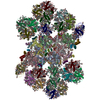
|
|---|---|
| 1 |
|
- Components
Components
-Protein , 3 types, 6 molecules rRoOxX
| #1: Protein | Mass: 29970.846 Da / Num. of mol.: 2 / Source method: isolated from a natural source / Source: (natural)  #11: Protein | Mass: 30614.748 Da / Num. of mol.: 2 / Source method: isolated from a natural source / Source: (natural)  #14: Protein | Mass: 9894.716 Da / Num. of mol.: 2 / Source method: isolated from a natural source / Source: (natural)  |
|---|
-Photosystem II ... , 14 types, 28 molecules aAdDhHiIjJkKlLmMtTwWzZYyCcBb
| #2: Protein | Mass: 39066.340 Da / Num. of mol.: 2 / Source method: isolated from a natural source / Source: (natural)  #3: Protein | Mass: 39474.031 Da / Num. of mol.: 2 / Source method: isolated from a natural source / Source: (natural)  #5: Protein | Mass: 9445.063 Da / Num. of mol.: 2 / Source method: isolated from a natural source / Source: (natural)  #6: Protein/peptide | Mass: 4245.035 Da / Num. of mol.: 2 / Source method: isolated from a natural source / Source: (natural)  #7: Protein/peptide | Mass: 5725.746 Da / Num. of mol.: 2 / Source method: isolated from a natural source / Source: (natural)  #8: Protein/peptide | Mass: 5062.142 Da / Num. of mol.: 2 / Source method: isolated from a natural source / Source: (natural)  #9: Protein/peptide | Mass: 4431.229 Da / Num. of mol.: 2 / Source method: isolated from a natural source / Source: (natural)  #10: Protein/peptide | Mass: 3762.433 Da / Num. of mol.: 2 / Source method: isolated from a natural source / Source: (natural)  #12: Protein/peptide | Mass: 3639.438 Da / Num. of mol.: 2 / Source method: isolated from a natural source / Source: (natural)  #13: Protein | Mass: 12155.054 Da / Num. of mol.: 2 / Source method: isolated from a natural source / Source: (natural)  #15: Protein | Mass: 6565.863 Da / Num. of mol.: 2 / Source method: isolated from a natural source / Source: (natural)  #16: Protein/peptide | Mass: 3333.058 Da / Num. of mol.: 2 / Source method: isolated from a natural source / Source: (natural)  #20: Protein | Mass: 50680.738 Da / Num. of mol.: 2 / Source method: isolated from a natural source / Source: (natural)  #21: Protein | Mass: 56159.820 Da / Num. of mol.: 2 / Source method: isolated from a natural source / Source: (natural)  |
|---|
-Cytochrome b559 subunit ... , 2 types, 4 molecules fFEe
| #4: Protein/peptide | Mass: 4986.013 Da / Num. of mol.: 2 / Source method: isolated from a natural source / Source: (natural)  #17: Protein | Mass: 9312.598 Da / Num. of mol.: 2 / Source method: isolated from a natural source / Source: (natural)  |
|---|
-Chlorophyll a-b binding protein, ... , 2 types, 20 molecules 123456vpqVPQUNGungSs
| #18: Protein | Mass: 27405.008 Da / Num. of mol.: 18 / Source method: isolated from a natural source / Source: (natural)  #19: Protein | Mass: 30742.830 Da / Num. of mol.: 2 / Source method: isolated from a natural source / Source: (natural)  |
|---|
-Sugars , 1 types, 10 molecules 
| #36: Sugar | ChemComp-DGD / |
|---|
-Non-polymers , 15 types, 542 molecules 
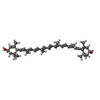
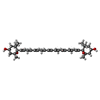

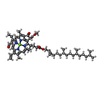
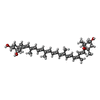





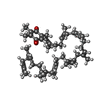

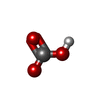















| #22: Chemical | ChemComp-CLA / #23: Chemical | ChemComp-LUT / ( #24: Chemical | ChemComp-XAT / ( #25: Chemical | ChemComp-LHG / #26: Chemical | ChemComp-CHL / #27: Chemical | ChemComp-NEX / ( #28: Chemical | #29: Chemical | ChemComp-CL / #30: Chemical | ChemComp-PHO / #31: Chemical | ChemComp-BCR / #32: Chemical | ChemComp-SQD / #33: Chemical | ChemComp-PL9 / |
|---|
 Movie
Movie Controller
Controller



 UCSF Chimera
UCSF Chimera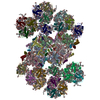

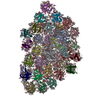

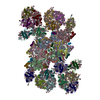
 PDBj
PDBj




















